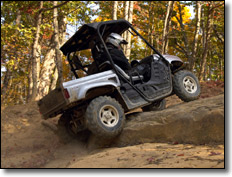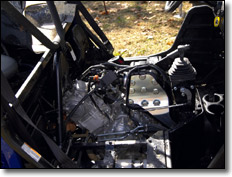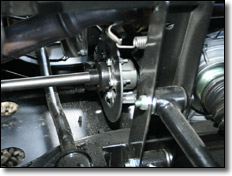 |
The Rhino
700 has plenty of power to go almost
anywhere you want to go as we climbed
over rocks and up big hill climbs with
any issues
|
As our ride got underway, there were a few
things that were quite apparent right from the
start was the increased power and smooth throttle
response. The new powerplant was very evident
in how quickly the Rhino 700 now accelerates
over the 660, but it is still rev limited to
just 40 MPH, but on our test ride, I was able
to max it out at 42 MPH, but it surely gets
there quick enough, and with an aftermarket
CDI, it will surely be capable of much higher
speeds. Also, the fuel injection has eliminated
the jerky throttle response as it is less reactive
to your foot vibrating over rough terrain causing
the vehicle to jolt forward unexpectedly.
We traveled through some tight trails and up
some steep hills to some high elevations in
the Tennessee Mountains and the fuel injection
worked exactly as expected as it adjusted to
the elevation change. Also, with the addition
of the YFI, the choke lever has been eliminated,
and the Rhino 700 started up effortlessly for
the ride even though the temperature was below
freezing in the morning.
 |
In less
than a few minutes, the engine is accessible
by removing the two seats and the center
console
|
In order to make all that increased power and
torque easier to handle, Yamaha had to do some
work to the clutch system. “All Yamaha automatic
utility and side by sides come with an Ultra-matic
transmission system. The key to the CVT clutch
is the centrifugal force clutch and a sprague
clutch. They provide excellent durability for
the belt because the belt never slips. The one-way
sprague clutch helps with downhill breaking, and
it gives a real natural feel to the engine braking.
You won’t feel it turn on and off; it’s
just a real consistent feel.” Said Biolsi.
We have to agree that this was a nice feature
on some of the steeper hills we encountered during
our test ride. In addition, CVT intake and exhaust
for the transmission is mounted about 5 inches
higher than it was before. On a side note, Yamaha
also offers a high altitude clutch kit so that
owners located in higher altitudes can get the
same great performance from the CVT.
With the larger engine, also came a larger
radiator that is 20mm higher and 28mm wider
has also been added to help keep the 686 engine
cool. The power plant for this machine is similar
to that of the Grizzly 700. There is a 5 valve
head and the cylinder lining has been dropped
for a ceramic, composite type and it’s
got roller rocker arms. “We also added
116% of crank shaft mass, by doing that we smoothed
out the power. The heavier fly wheel really
made a difference.” Stated Biolsi.
 |
The Rhino 700 still has Yamaha's signature
On-Command 4-wheel drive system, which allows
you to switch between 2-wheel drive, 4-wheel
drive with limited slip, and all-wheel drive
with full front differential lock with the push
of a button and flip of a lever. It should be
noted that the front differential lock should
only be used in really rocky or rough terrain
because it makes the steering quite heavy and
can cause driver fatigue on long rides, however,
the 4WD with limited slip makes it seem effortless
to go anywhere, and I never found it necessary
to engage the differential lock during our ride.
I was however impressed at how well the Rhino
performed in 2-wheel drive as it would go almost
anywhere despite some rear wheel spin, which
actually added to the experience, and I knew
if I found myself in trouble, 4-wheel drive
was available with just a push of a button.
 |
The shaft
mounted rear disk is now utilized just
for the parking brake
|
Yamaha also decided that with the increased
power, the Rhino 700 would benefit from a more
powerful braking system. “The 660 had
shaft mounted rear disk brake, the 700 has a
caliper and disk on each wheel, which gives
the machine a lot more breaking power.”
Biolsi noted. The new braking system also helps
to reduce driveline noise, and it worked exactly
as advertised when testing it on some of the
steep down hill trails on the ride.














